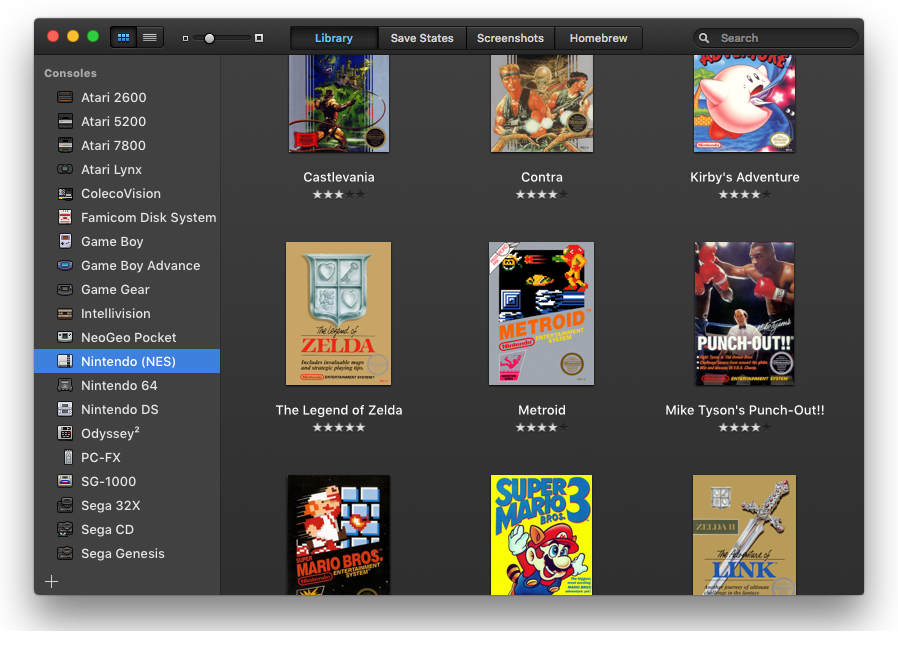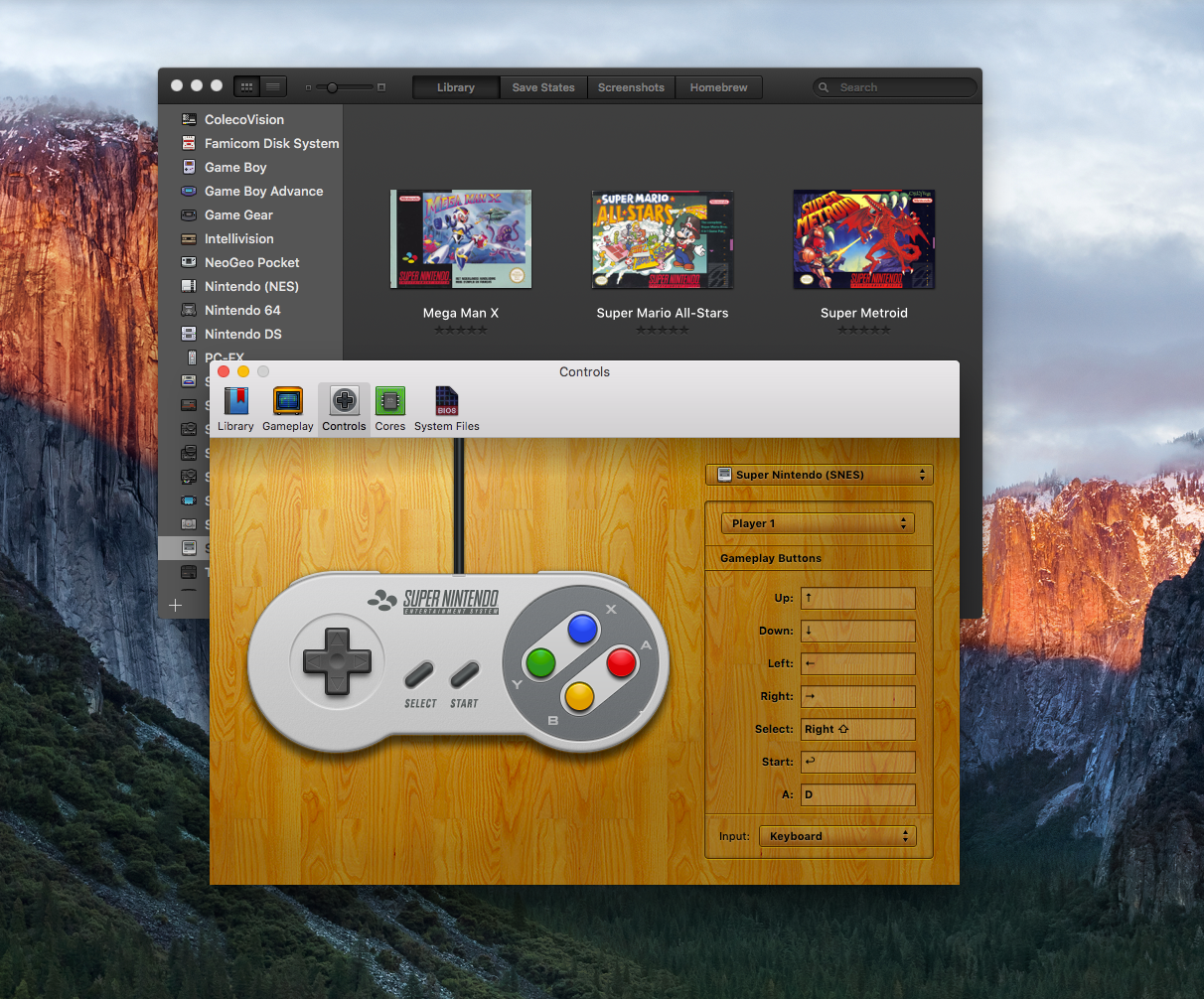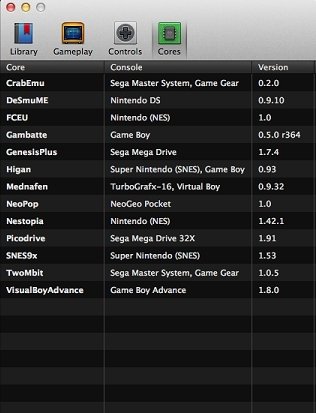OpenEmu is about to change the world of video game emulation. One console at a time. For the first time, the 'It just works' philosophy now extends to open source video game emulation on the Mac. With OpenEmu, it is extremely easy to add, browse, organize and with a compatible gamepad, play those favorite games (ROMs) you already own. Fixed newly imported Sega Saturn games crashing when loading on macOS 10.15 Catalina. — Saturn games imported using OpenEmu 2.1, as well as N64 and Sega/Mega CD, MUST be reimported to fully resolve the crash. Fixed toggling Display Mode screen options for NDS games. Fixed a rare crash when starting games in a fullscreen popout window. What’s worse–all the focus seems based on emulating games along with your Windows PC, but what if you’ve got a Mac? Do not despair, though, since OpenEmu is the perfect answer for retro players who just have access to macOS. If you have a Mac and fond memories of all game consoles past, keep reading. OpenEmu into the Rescue.
The Legend of Zelda and Megaman 2 on the Nintendo Entertainment System (NES). F-Zero and Street Fighter II: Turbo on the Super NES. Altered Beast and Strider on the Sega Genesis. If you have a Mac and fond memories of game consoles past, read on.
As companies move away from older consoles, or new operating systems render programs and ROMs unplayable, it has become a chore to preserve digital copies of games no longer available anywhere else. There are a number of ways to enjoy the old games you grew up playing—including building your own console—but the most accessible is the emulator, a program that lets you play any game in any operating system.
Websites like The Internet Archive and GOG.com are doing important work to ensure these titles don’t disappear. The vintage emulator scene is also evolving: The web is littered with dozens of programs promising different results, and not all ROMs are compatible with current operating systems. What’s worse—all the focus seems centered on emulating games with your Windows PC, but what if you have a Mac?
Dont despair, though, because OpenEmu is the perfect solution for vintage gamers who just so happen to prefer a macOS environment.
Games Games For Openemu Macbook
OpenEmu to the Rescue
Released in 2013, OpenEmu is not actually an emulator. Instead, it’s a robust front end for other console emulators. On its own, that’s nothing new; front ends have existed for a long time. OpenEmu differentiates itself by working a lot like a streamlined iTunes—that is, if iTunes were smooth and fast, not sluggish, confusing, and on its way out.
For example, OpenEmu shows you box art for each of your games, and automatically sorts them by platform. It lets you make playlists with your favorite games by category across platforms, and universalizes controller schemes for each emulated system—all with an easy-to-understand and attractive interface. OpenEmu doesn’t work for computer platforms—you’ll still need separate emulators for, say, the Atari 800 or 1040ST. But for game consoles, it’s outstanding. And for once, it’s a Mac exclusive.
The best part: OpenEmu takes care of the core emulation engines behind each platform. When I think of a front end, normally I think of a program I’ll have to install alongside a base emulator. But OpenEmu does all that work for you and comes packaged with integrated cores for popular systems you can download with the click of a button.

If you plan to play with OpenEmu, you want the Experimental version. That sounds dangerous, but in this case, it just means you’ll have vastly extended platform compatibility. Head to OpenEmu.org and click Experimental underneath the Download button and it will download to your Mac.
Download ROMs
Is Openemu Safe For Mac
OpenEmu will be able to play games, but you’ll have to download them separately. Before we go any further here, we must issue a standard disclaimer: It’s generally illegal to own ROMs of a given arcade machine, cartridge, or CD-ROM unless you own the actual item in question. In reality, though, it’s a gray area—especially for titles that aren’t available by any other means.
We can’t link directly to any ROM sites here, but they’re pretty easy to find. OpenEmu supports games for several Atari consoles, Game Boy, NES, Nintendo DS, Nintendo 64, Sega Genesis, Sony PlayStation, Sony PSP, Super Nintendo, and others. Once you’ve found your ROMs, go to the App Store and download The Unarchiver, which is a free program that can open the ROM packs you have.

You can add games to OpenEmu by dragging a ROM into the interface’s main window. OpenEmu will search the web for box art, but if it can’t find any, use Google Image Search to locate your own. Download it to your desktop, then drag the art over to the multicolor-banded image above the ROM, and the new image will replace it.
Don’t feel like messing with ROMs? OpenEmu actually includes a decent number of custom-built games, each made to look and feel like a classic console installment. Open the program’s main menu and select the Homebrew tab to view the list of games available. Classic Kong Complete, Pac-Man Collection, Super Bat-Puncher, and many others feel like they belong among your old-school collection.
Controller Setup
This is all well and good, but why play these great games using your Mac’s keyboard, when you can do it the right way with the proper controllers? OpenEmu states that it’s compatible with any HID-compliant USB or Bluetooth game controller.
OpenEmu also automatically maps controls for the PlayStation Dualshock 3 and 4, Nintendo Switch Pro Controller, and many other older systems. Xbox One controllers are compatible through a downloadable driver.
If you have a compatible controller, configure it by clicking on OpenEmu > Preferences > Controls. From there, you’ll see a wood background image with a drop-down menu for choosing systems. Choose a system, and you’ll see the console’s controls with a matching stock controller image on the left.
Next, plug in your USB controller or connect via Bluetooth, and click the Input menu below the Gameplay Buttons menu to choose the USB controller. Now click in each field and match the action with the corresponding button on your controller. This will ensure your controller is properly mapped to the controls of the game, no matter what system the game is for.
Recommended Controllers
If you don’t have a compatible first-party controller, there are plenty of third-party, USB-compatible models you can get online for a small price. We were able to test a few, and reccommend the controllers below. These options worked with my MacBook Pro on the first try in each case, with no extra drivers needed; all I had to do is set each one up within OpenEmu.
Classic NES USB Controller: As its namesake implies, this model copies the standard NES controller from 1985. It looks and feels great—maybe lighter than the original, but otherwise identical, and button feel is fine. I played several rounds of Super Mario Bros., the original Castlevania, Excitebike, Mike Tyson’s Punch-Out, Contra, and Ice Climber. All of them were dead-on.
Buffalo Classic USB Gamepad: This controller looks just like the stock Super Nintendo controller from 1991 except for two additional buttons, labeled Turbo and Clear, which you won’t need for most games. I set this one up and had no problem playing F-Zero, Street Fighter II Turbo, Super Castlevania IV, and Super R-Type. Verdict: It’s not quite as tight as a brand new Nintendo-brand SNES controller, but it’s much better than a worn-out one, and certainly better than the one sitting in your closet with the broken L button.
Logitech Gamepad F310: Similar to what you’d find on a PlayStation 2 or PlayStation 3, this model is also good for emulating the original PlayStation with the dual analog sticks added. It’s a little lightweight, but it’s accurate enough; you won’t wish for a different model with this one. I used this joystick to play Soul Blade and Ridge Racer on the PS1.
X-Arcade Tankstick + Trackball: This giant, expensive, venerable controller works great with any MAME emulator, including the one that comes with the experimental version of OpenEmu. It has two joysticks—which you’ll need for proper Robotron: 2084, Space Dungeon, and Smash TV play—as well as a center-mounted trackball that’s excellent for Centipede, and does a fine job as a stand-in for the larger Missile Command trackball seen on those machines.
Playing Games
To get playing, first choose a console from the left side of OpenEmu, then double-click on the box art of your game of choice. You’ll find that within OpenEmu’s standard emulators, replication accuracy is superb.
I hit one major snag during my emulator adventure: getting original Sony PlayStation games to work. This required a special ROM download in my tests, but with some fiddling, I figured it out. You need to download and drag over several BIOS files, including scph5500.bin, scph5501.bin, and scph5502.bin, and the last one can also be renamed from scph5552.bin if you can’t find it directly.
I also had to drag the files into ~/Library/Application Support/OpenEmu/BIOS, and not just rely on OpenEmu to find it on its own, before PS1 games would play on my test machine. OpenEmu is aware that several consoles require additional files to make work, so the program is able to identify what you need. Go to OpenEmu > Preferences > System Files to see which cores require additional BIOS files to work. Follow the directions on OpenEmu’s user guide on BIOS files.
One other thing you’ll want to do is add scan lines. You’re going to want some kind of screen emulation that makes the game look like it’s being displayed on a cathode-ray tube with reduced resolution. Otherwise, it’s screamingly obvious on a 1080p monitor how low-res all of these games were.
To enable this feature, head to OpenEmu > Preferences > Gameplay, and under Filter, choose Scanline. I like this one, but there are numerous other options in the submenu you may find more accurate or visually pleasing.
Besides running your games through OpenEmu, the program also offers a few additional features. If you’re done playing for the day, save your progress on the Save States page. OpenEmu can even auto-save for you. If you want to take screenshots while playing, use the Command-T keyboard shortcut to save the screen in the Screenshots page of the program.

Jason Cohen contributed to this story.
Let’s block ads!(Why?)
0As firms move away from old consoles and new working techniques leave many matches unplayable, it becomes more challenging to play all of your favourite games in the past. Game conservation has never been more important, however, the sector as a whole has largely failed here.
As good as it’s to have connections to Xbox Game Pass, PlayStation Currently, or even Nintendo Switch Online, these services may be shut off at any given moment. Nintendo’s shuttering of the Wii’s Virtual Console is proof that these aren’t real options.
There are a lot of approaches to enjoy the previous games that you grew up playingincluding creating your own machine or purchasing a retro console–however, the most readily accessible is the emulator, a program which lets you play any sport in almost any operating system.Read about original xbox iso roms At website

Regrettably, the web is currently littered with heaps of apps promising distinct benefits, and not all ROMs are compatible with all systems that are operating. What is worse–all the attention appears centered on emulating games with your Windows PC, but imagine if you’ve got a Mac?
Don’t despair, though, because OpenEmu is the best solution for retro gamers who just have access to macOS. When you have a Mac and fond memories of all game consoles past, read on.
OpenEmu to the Rescue
Published in 2013, OpenEmu isn’t actually an emulator. On the contrary, it’s a strong front end for other console emulators. On its own, that is nothing new; leading ends have existed for a long moment. OpenEmu differentiates itself by working much like a compact iTunes–which is, if iTunes were eloquent and quick, not dumb, confusing, and lifeless.
For instance, OpenEmu has a built-in library which shows you box art for each of your matches, and automatically sorts by stage. In addition, it lets you create custom sets across multiple programs and universalizes control schemes for each emulated system. It all comes wrapped within an easy-to-understand and attractive interface.
The very best part is that OpenEmu handles the center emulation motors behind every platform. You don’t have to search down the perfect center that is compatible with the ROM you might have. After you put in OpenEmu, it already comes packed with a large variety of incorporated cores. Many programs have multiple cores contained, so there is never an issue with incompatibility.
Head to OpenEmu.org and click Experimental under the button. This may sound dangerous, but it just means you’ll have vastly extended platform compatibility, but along with a few features that are still in evolution.
OpenEmu may play games out of the gate, but you’ll need to download them separately. But first, a typical disclaimer: it’s generally illegal to possess ROMs of a specific arcade machine, cartridge, or CD-ROM unless you own the real item in question. In fact, though, it is a gray area–especially for titles that aren’t accessible by any other means.
While we can’t directly link to some ROM sites here, they are rather simple to discover. Most websites are reliable but some can seem sketchier than others. Use your very best judgment when downloading files from the world wide web, and you can run them through an anti-malware program to be on the safe side.
In principle, OpenEmu can be compatible with a arcade ROMs, but support is experimental and also your achievement obtaining these games to run may vary. If you run across JAMMA or even Neo Geo games in your hunt, they won’t do the job.
Games such as home computers in the’70s and’80s aren’t supported–you’ll need separate emulators for, say, the Atari 800 or 1040ST.
Add ROMs into Library

When you get into a ROM file, they typically come zipped inside a zip or 7-zip file. The built-in Archive Utility on your Mac should be able to open these records, however if you’re looking for something more powerful, you may download The Unarchiver.
Once the file is unzipped, you should possess the ROM–normally a .nes or even .gbc file, based on the console, while larger games may be .ISO documents –and maybe a few supporting text files you do not desire for playing. Add the ROM to OpenEmu by dragging the file directly into the interface’s key window. The program virtually always knows just where to put the file, but when it’s in the wrong place, you can drag it into the suitable folder.
To get MAME ROMs, leave the file zipped. Drag on the zipped file to the Arcade section of OpenEmu, along with the match should display. It could appear at the wrong folder, or perform anything else wonky.
When a ROM is included, OpenEmu will search the web for box art, but if it can not find any, use Google Image Search to find your own. There is no downloading required–you can come across an image (.JPEG or .PNG document ) and drag it straight on the empty space where the box art ought to be. By default, all games have been stored in ~/Library/Application Support/OpenEmu/Game Library, however this may be altered in OpenEmu > Preferences > Library.
When you add a file, you might observe that the original ROM continues to exist on your computer. This is because OpenEmu does not just transfer a ROM’s location, it actually duplicates the document . 1 variant will exist within your hard drive’s Application Support files, while the original will probably exist in your desktop, downloads folder, or wherever you have it stored.
This is important because you ought to probably watch on how much you’re downloading. While all 8- and – 16-bit game ROMs simply take up a couple of kilobytes or megabytes of space, documents for more modern system will begin to take up hundreds of megabytes or even several gigabytes. A few PlayStation games may even require you to download multiple discs to find the whole game.
Having replicate files around may result in trouble, so once you affirm a match functions in OpenEmu, then you may safely delete the first ROM.
ROMs along with BIOS Files
One key complication when playing retro games will be that some programs require BIOS files to do the job. If you would like to play with games for the original PlayStation or Sega Saturn, for instance, you will first have to track down these distinctive ROM files. OpenEmu includes a user manual on BIOS documents, but it is not too complex that you can’t figure it out yourself.
The fantastic news is that OpenEmu is smart enough to understand what’s missing. If you run into a problem similar to this, a message will appear on the display to tell you precisely what documents you need to download. From there, It’s just a matter of hunting down the perfect documents and getting them inside the system.
For PlayStation games, then you’ll need several BIOS documents, including scph5500.bin, scph5501.bin, and scph5502.bin, and the last one may likewise be uninstalled from scph5552.bin if you can not locate it directly. Sega Saturn games will require files named sega_101. Bin and mpr-17933. bin.
Some games console add-ons such as the Sega CD, Sega 32X, along with the TurboGrafx-CD are encouraged, but may also be somewhat finicky. OpenEmu will ask you to read the user guide before you attempt to bring any disc-based games.